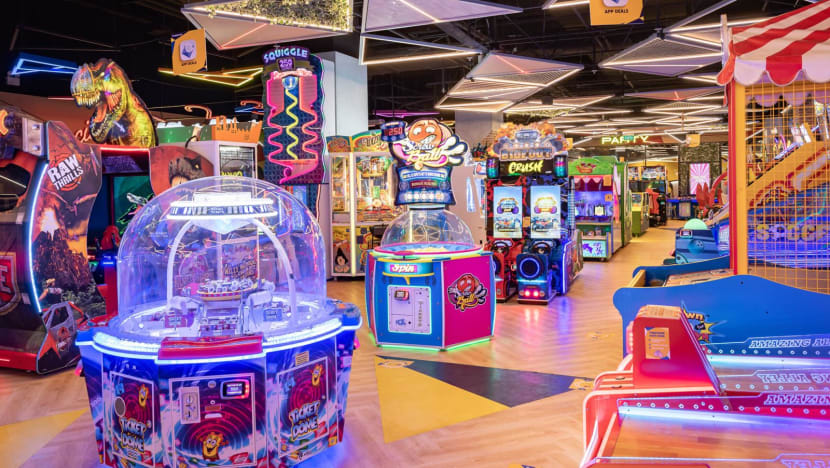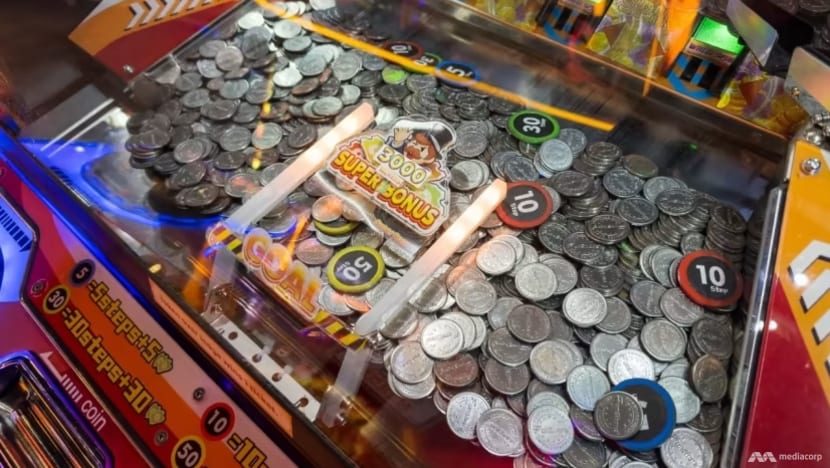'Prize doesn't matter': Arcadegoers unfazed by impending S$100 limit on rewards
One arcade operator says only a “small portion” of its customers redeem high-value prizes.

A Timezone arcade outlet at the Parkway Parade shopping centre. (Photo: Facebook/Timezone Singapore)

This audio is generated by an AI tool.
SINGAPORE: Arcadegoers in Singapore are not concerned about upcoming restrictions on prizes offered at such entertainment venues, with several saying they do not play for expensive rewards.
From Mar 1, the value of prizes offered at arcades and fun fairs must be less than S$100 (US$74), to reduce the risk of gambling inducement.
Operators must also not offer cash, cash equivalents, credit, merchant vouchers or coupons as prizes, the Ministry of Home Affairs (MHA) said in a statement in early February.
At the Cow Play Cow Moo arcade outlet at Downtown East, a 35-year-old who only wanted to be known as Ms Wong said the most expensive prize she had won was a G-shock watch worth about S$150.
But she added that she was “not that big” a player and that the “prize doesn’t matter that much” to her. She simply enjoys the games at the arcade, which she stops by once a week and spends about half an hour each time.
This sentiment was echoed by Mr Loh, who was counting a thick stack of trading cards when CNA approached him.
Mr Loh, who is in his 40s and did not want to be named in full, told CNA he spends between S$30 to S$50 when he visits the arcade.
On the upcoming prize cap, he said: “The crux of the issue here is you want to cap it at S$100 so people don’t squander away their savings just to get iPads (and) mobile phones.”
"But I don't go for those things," added Mr Loh, who usually aims for prizes such as collectible cards.
Over at Paco Funworld at Bugis+, most patrons CNA approached were not even aware of the prize cap, while those who did were similarly unconcerned.
Ms Chia, who visits the outlet once a month with her two kids, also highlighted that she does not go for bigger prizes and mostly aims for those appropriate for children such as school bags or plush toys.
“SMALL" PORTION REDEEM HIGH-VALUE PRIZES
In its statement in February, MHA said that it had notified all operators of the restrictions since early 2023.
An advisory was also issued to them earlier this year to encourage them to inform their customers of the upcoming restrictions.
Mr Nesh Selva, general manager of The Entertainment and Education Group (TEEG) which is the parent company of Timezone Singapore, told CNA the arcade has “proactively" informed customers of the new policy through social media as well as notices at its venues.
He added that only a “small" portion of Timezone’s guests redeem high-value merchandise.
“High-value items currently form a minimal part of our overall inventory, and we anticipate minimal disruption to our core operation."
Customer enquiries around the new regulation have also been manageable as Timezone places “very little" emphasis on high-value prizes, said the general manager.
“We do not view these new regulations as posing challenges, and are in fact, supportive of this move towards responsible gaming and a heightened focus on social experiences over material rewards,” he added.
On how the arcade will continue to keep prizes attractive after restrictions kick in, Mr Nesh noted that Timezone has a "comprehensive" merchandise selection catering to different age groups, interests and occasions.
Arcade operator Cow Play Cow Moo declined to comment, while other companies such as Paco Funworld, Zone X and The Wonderful World of Whimsy did not reply to CNA’s queries.

PRIZE CAP A GOOD START: EXPERTS
In 2021, MHA invited members of the public to provide feedback on its then-proposal to implement a cap on the value of prizes for mystery boxes, arcade games and claw machines.
While many in Singapore consider arcade games and claw machines as a form of entertainment, there is a need for safeguards to ensure that these activities do not induce gambling behaviour and cause social problems, said the ministry.
Addiction specialists CNA spoke to noted that games at arcades and fun fairs still contain gambling elements, even if disguised in various forms.
These include rewards that are heavily based on chance or luck instead of skill, and machine designs such as coin-pushers that resemble slot machines in casinos, said Ms Joanna Kong, executive director of One Hope Centre, a non-profit organisation that helps those with behavioural addiction.
There is also plenty of audio-sensory stimulation with flashing lights and loud sounds to arouse excitement and gameplay, giving players the impression they are almost winning - known as the “near-miss” effect - to encourage them to keep going, Ms Kong added.
Daily Cuts - Why are arcade games so addictive?
In addition to the games, high-value prizes make the prospect of winning even more attractive, she noted.
With high stakes and high rewards, some players might be encouraged to spend more money on the games in the hope of winning a high-value prize.
Likewise, Otium Mindhealth's senior consultant psychiatrist and medical director Lui Yit Shiang said: “If we allow small prizes to be won more frequently, the brain registers pleasure and gets conditioned to return to that same setup.
“And if the game rules that the higher the stakes, the greater the prize, the brain would tell the player to keep returning to place higher stakes to win, regardless of the earlier losses."
Some individuals are more prone to this notion of betting without realising the consequences, as reward conditioning has overtaken judgment, said Dr Lui.
High-value prizes such as the latest handphone or audio system models are "eye-catching" and entice players to go for bigger bets, he said, adding that this can be particularly harmful to minors or those with poorer economic judgment.
The experts welcomed the S$100 cap on prizes, calling it a good start in discouraging gambling.
One Hope Centre’s Ms Kong said the cap could reduce the attractiveness of rewards and de-incentivise some players.
Moreover, a S$100 prize can still be “reasonably attractive” for a child or teenager, she added.
But Ms Kong also said many problem gamblers play not for the prize, but for the experience. “While the prize cap can reduce the attractiveness of the prize, the pleasurable experience associated with these machines and their gambling elements still remain.
“Some players may be conditioned to be stimulated by these gambling elements, and it will not be too big of a step-up for them to move on to more conventional gambling games such as slot machines,” she added.
Mr Andy Leach, director of addiction services at the Visions by Promises treatment centre, said that for gamblers, it was not about winning or losing.
“The process of sitting in an arcade and playing games, and the expectation of whether (they) will win or not," he said. "That will always be there despite the fact that (prizes have) been capped."
















